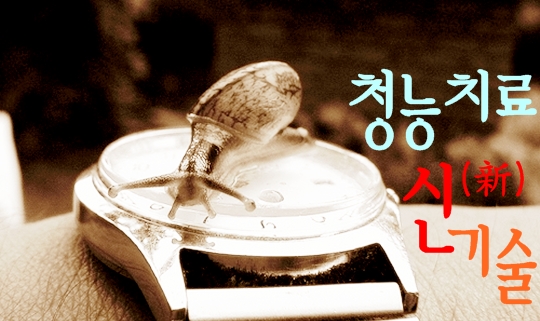
과학전문지 '네이처(Nature)' 최신호(2008년 8월27일자)에 청각기능에서 핵심적인 역할을 하는 유모세포(hair cell)를 재생할 수 있는 방법이 개발되었다라는 내용이 발표되었습니다.
이 내용을 요약하면 다음과 같습니다.
Functional auditory hair cells produced in the mammalian cochlea by in utero gene transfer
Samuel P. Gubbels1,4,5, David W. Woessner1,4,5, John C. Mitchell2, Anthony J. Ricci3 & John V. Brigande1
- Department of Otolaryngology, Oregon Hearing Research Center, and,
- Department of Restorative Dentistry, Division of Biomaterials and Biomechanics, School of Dentistry, Oregon Health & Science University, 3181 SW Sam Jackson Park Road, Portland, Oregon 97239, USA
- Department of Otolaryngology-Head and Neck Surgery, Stanford University School of Medicine, 801 Welch Road, Stanford, California 94305, USA
- These authors contributed equally to this work.
- Present addresses: Department of Surgery, Division of Otolaryngology, University of Wisconsin – Madison, K4/719 CSC, 600 Highland Avenue, Madison, Wisconsin 53792, USA (S.P.G.); Department of Pharmacology and Toxicology, University of Utah, College of Pharmacy, 30 South 2000 East, Room 201, Salt Lake City, Utah 84112, USA (D.W.W.).
Correspondence to: John V. Brigande1 Correspondence and requests for materials should be addressed to J.V.B. (Email: brigande@ohsu.edu).
Sensory hair cells in the mammalian cochlea convert mechanical stimuli into electrical impulses that subserve audition1, 2. Loss of hair cells and their innervating neurons is the most frequent cause of hearing impairment3. Atonal homologue 1 (encoded by Atoh1, also known as Math1) is a basic helix–loop–helix transcription factor required for hair-cell development4, 5, 6, and its misexpression in vitro 7, 8 and in vivo 9, 10 generates hair-cell-like cells. Atoh1-based gene therapy to ameliorate auditory10 and vestibular11 dysfunction has been proposed. However, the biophysical properties of putative hair cells induced by Atoh1 misexpression have not been characterized. Here we show that in utero gene transfer of Atoh1 produces functional supernumerary hair cells in the mouse cochlea. The induced hair cells display stereociliary bundles, attract neuronal processes and express the ribbon synapse marker carboxy-terminal binding protein 2 (refs 12,13). Moreover, the hair cells are capable of mechanoelectrical transduction1, 2 and show basolateral conductances with age-appropriate specializations. Our results demonstrate that manipulation of cell fate by transcription factor misexpression produces functional sensory cells in the postnatal mammalian cochlea. We expect that our in utero gene transfer paradigm will enable the design and validation of gene therapies to ameliorate hearing loss in mouse models of human deafness14, 15.
1. 연구개발자 :
존 브리갠드(John V. Brigande) 박사팀 [오리건 보건과학대학, USA]
2. 연구방법 :
쥐실험을 통해 특정 유전자(Atoh1)를 조작하여 유모세포를 생성시킴.
3. 연구결과 :
쥐의 자궁에서 자라는 배아의 유전자(Atoh1)를 조작한 결과 태어난 새끼들은 다른 보통 새끼들 보다 귀의 유모세포가 많음.
→ 유전자 조작으로 유모세포를 만들어 낼 수 있음을 보여줌.
4. 연구기대효과 :
1) 이 방법을 배아줄기세포 또는 성체세포의 유전자 재프로그래밍 연구와 결합시키면 새로운 유모세포를 만들어 청각이 손상된 환자에게 이식 가능함.
2) 내이에 있는 유전자를 직접 조작해 새로운 유모세포의 생성을 촉진가능함.
인간에 있어서 난청의 직접적인 원인중 약 60~90%가 유모세포 손상입니다. 약 1만5천500개인 유모세포는 노화, 심한 소음, 유전결함, 약물 부작용, 감염 등으로 손상될 수 있는데, 한번 손상되면 재생이 불가능하기 때문에 한번 손상된 유모세포를 재생한다는 것은 난청장애를 획기적으로 극복할 수 있는 유일한 방법이라고 할 수 있습니다.
따라서 존 브리갠드 박사팀의 유모세포 재생은 비록 쥐 실험에서 가능하지만 추후 인간의 귀에서도 재생이 가능한 연구결과를 기다려봅니다.

'청능치료 신기술' 카테고리의 다른 글
| 스타키보청기 신기술 'TeleHealth' : 전화기에 의한 보청기 무선 조절(휘팅,fitting) (0) | 2010.05.19 |
|---|---|
| 줄기세포(stem cell)를 이용하여 동물의 청력(유모세포)을 복원하다 (1) | 2008.11.25 |
| 이식형 보청기, RetroX의 구조 및 적용 대상 (0) | 2008.10.05 |
| 스타키보청기 인공지능 `나노보청기` 데스티니 1600 출시 (0) | 2008.10.05 |
| Baha(이식형 골전도 보청기)에 대해 공부해 볼께요. (0) | 2008.09.04 |
